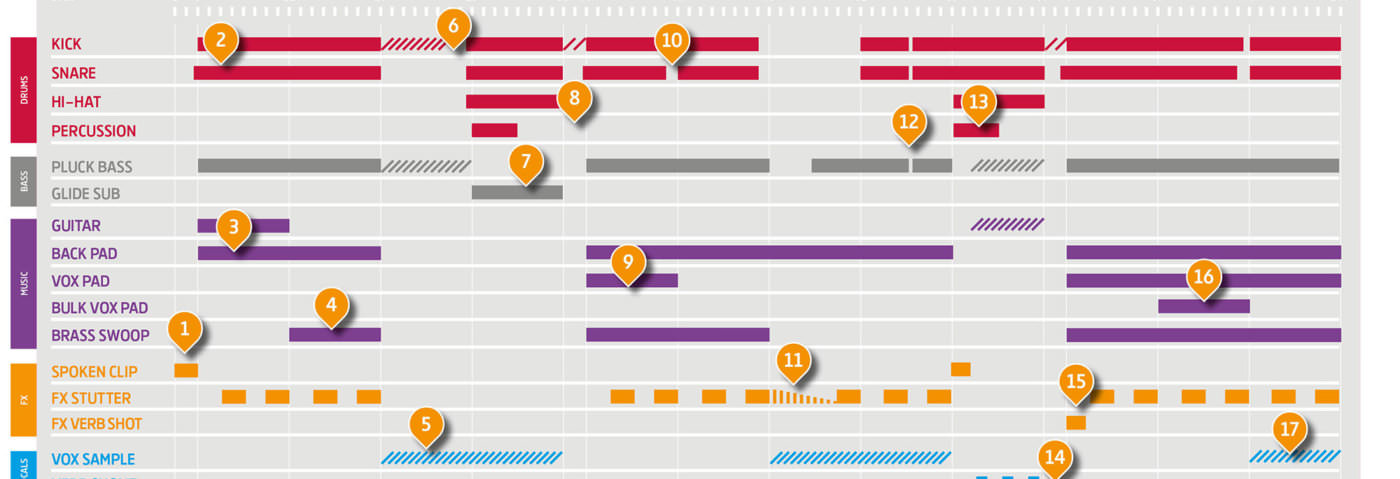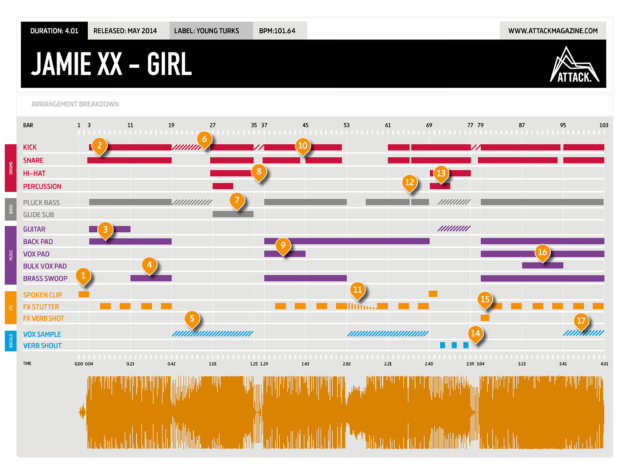By popular demand, we deconstruct the arrangements of tracks to see what we can learn from their structure.
In our latest deconstruction we tackle a more complex arrangement, replete with two-bar turnarounds, heavy use of filter automation and intricate pad layers: Jamie xx’s compelling, sample-heavy opus ‘Girl’.
The track
The arrangement
Click to enlarge.
What’s happening?
1. The track opens with a spoken word clip – “You’re the most beautiful girl in Hackney, you know?” – a mood-setter that pushes the start of the arrangement proper to the third bar. It means that the 8-bar turnarounds that would fall at 8, 16, 24 in a more conventional structure are shifted back in time to 3, 11, 19. The move is a declaration of intent: this is not going to be a typical dance arrangement.
This is not going to be a typical dance arrangement...
2. One beat before the song begins, a single snare hit pre-empts the drum part’s entry. The beat is absurdly simple: a layered kick and snare. In lesser hands it might have sounded dull, but Jamie Smith does three things to ensure it works. Firstly, the snare is heavily layered and reverbed to give it character and definition. Secondly, the bulk of the rhythmic work is done not by the beat but the riff-style plucked bassline. Thirdly, he fills the upper reaches of the frequency spectrum with FX stutters that fill out the mix where hi-hat and percussion would usually reside. Both the bass sound and stutters (as well as the pads) are samples from the Studio track ‘Out There’.
3. The track opens with a sparse guitar line, sampled from The Whitest Boy Alive’s ‘Burning’, underpinned by a rich backing pad, mixed low and with a filter rolled down so that it glues the upper mix elements with the plucked bass.
4. When the guitar drops out, a repeated melodic motif plays: a haunting synthesised brass ‘swoop’, heavily reverbed. The shimmering FX stutter continues to dominate the upper frequencies, but note that when it plays it’s not a constant; instead it’s triggered during the last two bars in each four. Note also its stereo interest, with the sound slowly shifting between left and right channels.
5. At bar 19 it’s all change. The kick and plucked bass are filtered way back. It’s a technique used throughout the arrangement with more than a few nods to classic filtered house production. With all but the lowest frequencies clear, it’s time for the track’s key melodic motif to play for the first time: a heavily re-pitched and processed vocal sample (“I want you back…”) lifted from Freeez’s ‘I.O.U.’ This follows the same cutoff trajectory as the kick and bassline, with the filter opening over the course of the 8-bar section. Listen out for Smith’s use of reverb and delay here. It’s particularly noticeable when exposed on parts like the vocal, but it’s pretty much on every musical element, combining to make up the deep, lush sound palette that characterises the production.
6. The full beat comes in at bar 27. This time an open hi-hat, mixed loud, and a stumbling, almost out-of-time percussive part join the kick and snare. Two things add further interest. First the entry of the kick, snare and hi-hat two bars before the 8-bar section. It’s the same pre-emptive trick displayed at bar 7 but this time with more beat elements. Secondly, the percussion only stays in the mix for 4 bars, rather than the 8 the listener might expect.
The bassline plays a key role in bringing movement to 'Girl', doing much of the rhythmic heavy lifting that a more complex beat would normally deliver
7. The bassline plays a key role in bringing movement to ‘Girl’, doing much of the rhythmic heavy lifting that a more complex beat would normally deliver. But at bar 27 the plucked bass is substituted for a deeper synthesised sub bass. It starts the 8-bar section following the same MIDI pattern as the plucked bass but then the percussion drops out and it goes off-piste, sliding up the octaves before a high-pass filter edges upwards to remove the low end and lead us into…
8. …This two-bar break is the first of two in ‘Girl’. Once again, a low-pass filter is clamped down on the kick drum with all other mix elements cut. Shifting from an 8-bar turnaround to just two is typical of the arrangement, which constantly toys with the expected and messes with convention. Two more things to note: one, the now established ‘pre-empting’ snare hit that is becoming something of a trademark characteristic of the song; two, the delay tails of the vocal sample are totally exposed as it lingers into the break.
9. The music returns, joined for the first time by a new, lush vox-style pad, mixed prominently.
10. There is something to interest the ears throughout this track. At bar 44 the kick and snare are muted momentarily to allow the bass, performing its trademark walking run, to take centre stage. The same trick is repeated at bar 51.
11. The heavily filtered vocal sample returns above the backing pad as for the first and only time in the song the fizzing FX stutter exchanges its previous two-bar pattern for a sustained decline in volume before returning at full volume to foreshadow the return of the beat into bar 61.
12. Bar 65 sees a nifty reinterpretation of the kick/snare mutes at bars 44 and 51, with the drums (and bass) dropping out at the start of a four-bar section, rather than at the end of it.
13. The full beat is back as the melodic elements drop out. A heavily reverbed vocal snippet (“I know you can”) echoes the spoken word quote that opened the track while a shouted “no” drenches the mix with tape echo. At bar 71, the lilting guitar part makes a brief reappearance, underpinned by an insistent new pattern on the plucked bass – both parts opening into the mix as their filter cutoff points rise.
Listen to the sublime down-pitching echoes from the verb shout – space delay done with panache
14. It’s the 2-bar break again. Listen to the sublime down-pitching echoes from the reverbed shout: space delay done with panache.
15. The usual single snare pre-emption opens the final section of the song – with pads swelling, synth brass swooping and a single reverb-heavy FX shot giving an additional shot of interest.
16. The emotion reaches full force as a second instance of the vox pad enters the mix in the upper registers. It’s mixed so loud that it pushes against the mix bus compressor, pushing all other elements back in the mix. Bar 94 sees the kick and snare drop out, repeating the same trick exploited in the bar 37-53 section.
17. The energy winds down, with a simpler, stripped-down instance of the vocal sample issuing a last refrain as the track comes to its abrupt end.





10.52 PM
What I find funny and interesting is that the official Young Turks video is already a kind of highly-simplified but highly-visual deconstructed beat 😀 On the left, the bass, the brass swoop and the guitar while the right owns the kick, the snare, the hi-hats and the FX stutter 😉
Anyway, good job on the article, it’s much appreciated ! Please go on with them 🙂
08.28 PM
I’m sorry but this is incredibly stupid. He’s not “changing the conventional structure” or anything like that. There is just a silly sample before the song starts its normal 8 bar structure. If anyone has ever DJ’ed before you know that COUNTLESS songs do this; you just find the first beat and mix from there. To say that his structure is pushed back to “3, 11, 19” is so retarded that it makes me want to die on the inside.
If I open my track with a reverse cymbal sample leading into the first beat, I’m not pushing any artistic boundaries by starting my song on the “second bar,” there is just some sound that happens before the first beat. There is no declaration of intent. It’s still going to be the same damn 8 bar structure like all popular dance music.
08.42 PM
@booksrgay
(except they’re not)
– well, yeah, I see your point but don’t see how that actually contradicts what’s said above. It’s true; the opening speech bit *does* push the structure back to 3, 11, 19 – that’s all that’s said. And it’s true!
and contrary to what you say about “the same damn 8 bar structure”. Again – it’s not. That’s the point of this article I think! Jamie regularly using 2 bar turnarounds – breaking the “damn 8 bar structure”.
sounds like a chill pill in order !!!
06.14 AM
great feature, I’m a spatial visual learner so these graphics actually go really far for me. I’ve had a great time actually checking out the songs on splice.com, which displays project in a similar way.
Anyways, I’d love to see a track by tobacco or somebody integrating a hip-hop style rhythm into electronic music. Maybe even a Gorillaz track or something. I love making dance music but struggle getting that fusion in my sound with hip-hop.
01.48 PM
I like this decontrsucted post again. I don’t like vocal tracks. It is just something weird in my head haha
01.40 PM
Does the Glide sub comes in at the end again…?
02.07 PM
What is the program you do your graphics for arrangment?
03.41 AM
It would be cool if you guys made some type of app or something that would allow us to do our own deconstruction in that similar style. 🙂
03.36 PM
@tony and @n00b – you can create your own deconstructed using Splice!